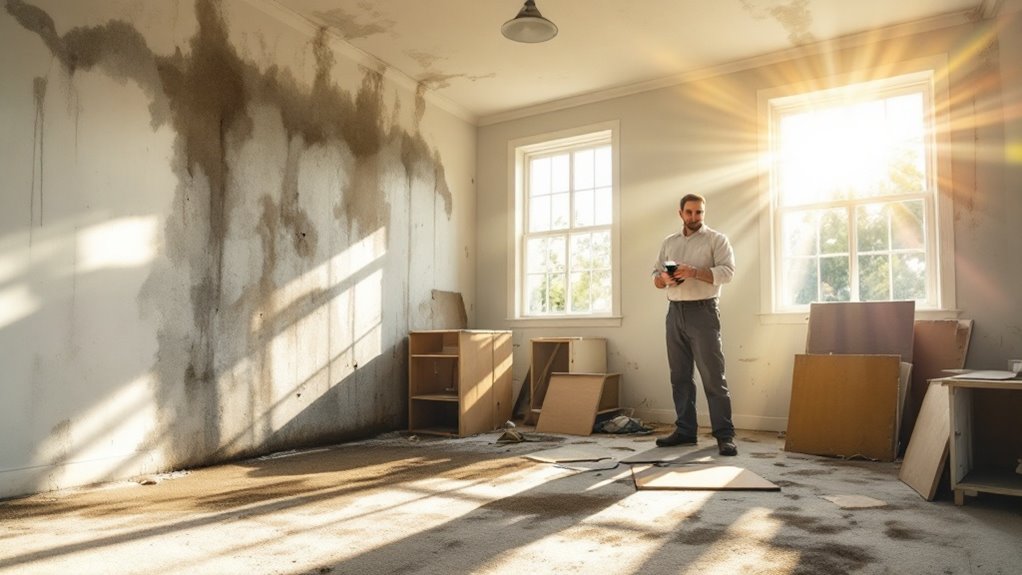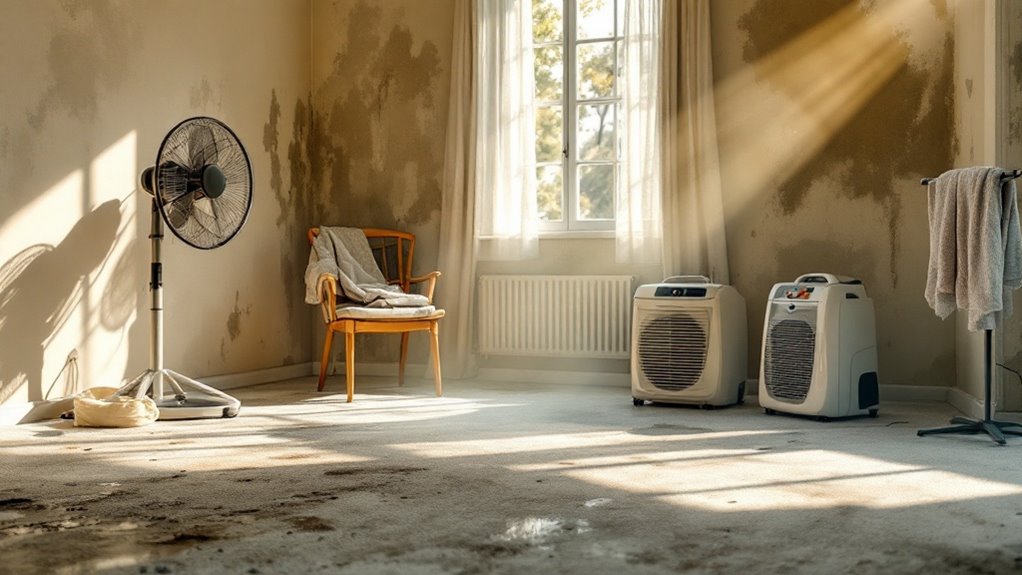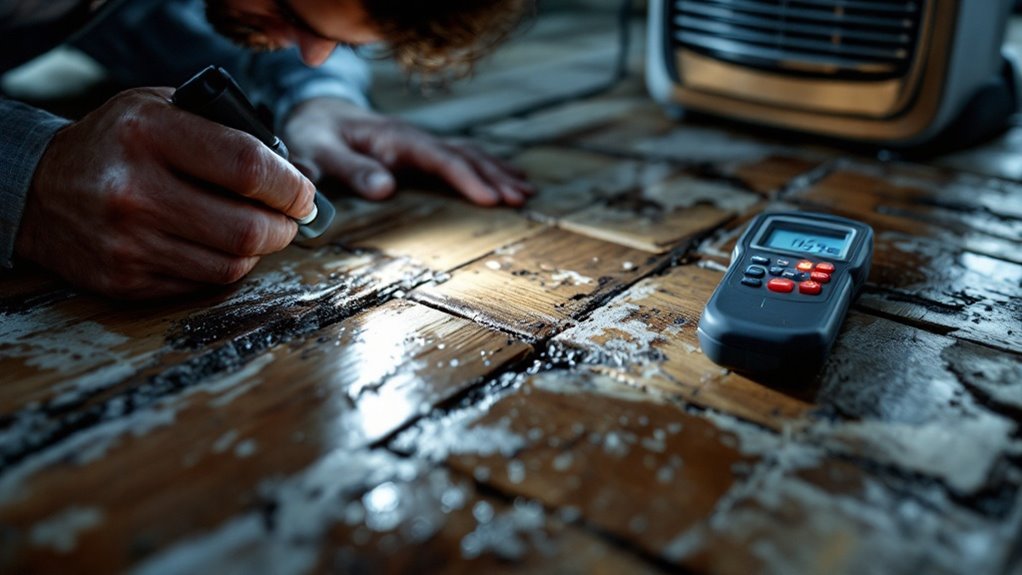Did you know that mold can begin to grow within just 24 to 48 hours after a flood or pipe burst? This rapid timeline makes it vital to act quickly and effectively to prevent mold infestations. From evaluating the damage to choosing the right materials for repairs, there are several key steps you need to follow. Understanding these can save you time, money, and health issues in the long run. Let’s investigate how you can tackle this challenge.
Key Takeaways
- Thoroughly inspect and document all water-damaged areas, including walls, floors, and belongings, to identify potential mold growth spots.
- Remove standing water promptly using pumps and vacuums, then dry affected areas with fans and dehumidifiers to reduce moisture levels.
- Clean and disinfect surfaces with appropriate solutions to eliminate mold spores and prevent regrowth, ensuring areas dry completely afterward.
- Regularly monitor indoor humidity levels with a hygrometer, keeping them between 30% and 50% to minimize mold growth risk.
- Use moisture-resistant materials in repairs and renovations, and ensure proper ventilation in high-risk areas to deter future mold development.
Assessing the Damage

After a flood, it’s crucial to evaluate the damage quickly to prevent mold growth. Start by inspecting your home thoroughly. Look for water-soaked areas, including walls, floors, and ceilings. Check furniture, carpets, and any belongings that might’ve been affected. Pay particular attention to hidden spaces like basements and attics, where moisture can linger unnoticed.
Take notes and document everything with photos for insurance purposes. If you notice dampness, discoloration, or a musty odor, these are signs that mold might develop if not addressed promptly. Don’t forget to check appliances and electrical systems, as water damage can cause hidden hazards. By evaluating the damage promptly, you can take the right steps to mitigate mold growth and protect your home. Additionally, early intervention is crucial to prevent costly repairs and health hazards.
Removing Standing Water
Once you’ve assessed the damage, your next priority is removing any standing water, as it creates an ideal environment for mold to thrive. Start by gathering the right equipment to tackle the task effectively.
- Submersible pump: If the water is deep, this tool can quickly remove large volumes.
- Wet/dry vacuum: Perfect for smaller pools of water and tight spaces.
- Mops and buckets: Handy for any leftover moisture after using larger equipment.
- Fans and dehumidifiers: Useful to aid in drying out the area once the bulk of the water is gone. Additionally, utilizing industrial-grade pumps can expedite the water extraction process and significantly reduce the risk of mold growth.
Drying Out Affected Areas

Once you’ve removed standing water, it’s essential to focus on drying out the affected areas. Use dehumidifiers effectively to pull moisture from the air and prevent mold growth. The sooner you act, the better your chances of keeping your home mold-free. Regular inspection of drainage systems helps prevent water accumulation and further issues after a flood or pipe burst.
Remove Standing Water
To tackle mold prevention effectively, you need to act quickly by removing any standing water from affected areas. The longer water sits, the higher the chance for mold growth. Start by evaluating the situation and gather the right tools to help you.
- Use a wet/dry vacuum to suck up water from floors and carpets.
- Mop up any residual water to guarantee surfaces are dry.
- Open windows and doors to promote airflow, aiding in drying.
- Inspect hidden spaces like basements and crawl spaces for trapped water.
Use Dehumidifiers Effectively
After removing standing water, it’s time to focus on drying out the affected areas to prevent mold growth. Using dehumidifiers effectively is essential. Place them in rooms with the highest humidity levels, ideally in enclosed spaces where moisture lingers. Turn them on immediately after water removal to accelerate the drying process. Make sure to empty the water collection tank regularly, or connect a hose for continuous drainage. Keep windows and doors closed while the dehumidifiers are running to trap moisture inside. Monitor humidity levels with a hygrometer; aim for a reading below 50%. Finally, run the dehumidifiers for several days until everything feels dry to the touch. This proactive approach helps safeguard your home from mold.
Cleaning and Disinfecting Surfaces
Cleaning and disinfecting surfaces is essential in preventing mold growth after a flood. You need to act quickly to remove any moisture and contaminants. Start by gathering your cleaning supplies and follow these steps:
- Use a mixture of water and detergent to scrub surfaces thoroughly.
- Rinse with clean water to remove any residue.
- Apply a disinfectant to eliminate germs and mold spores.
- Allow surfaces to dry completely to prevent further moisture buildup.
Inspecting for Hidden Moisture

After a flood, it’s vital to check for hidden moisture that could lead to mold growth. Start by inspecting behind walls and under flooring materials, as these areas often trap water. Catching moisture early can save you from costly repairs and health issues down the line.
Check Behind Walls
While you may have dried out the visible areas of your home, it’s crucial to check behind walls for hidden moisture that can lead to mold growth. Moisture can linger in cavities and other concealed spaces, creating an ideal environment for mold spores to thrive. To effectively inspect behind your walls, consider these steps:
- Use a moisture meter to detect high humidity levels.
- Remove baseboards to access wall cavities.
- Check for water stains or discoloration on the drywall.
- Look for musty odors that signal moisture presence.
Examine Flooring Materials
One of the most critical steps in preventing mold growth after a flood is to examine your flooring materials for hidden moisture. Start by checking carpets and rugs; they can trap water underneath, creating a perfect environment for mold. If they’re soaked, consider removing them entirely to dry out the subfloor.
Next, inspect hardwood and laminate floors. These materials can absorb moisture, leading to warping and mold if not addressed. Use a moisture meter to check levels in the subfloor, and if readings are high, you may need to lift the flooring to allow for proper drying.
Repairing Water Damage
Once you’ve removed the water, it’s crucial to start repairing the damage to prevent mold growth. Begin by evaluating the affected areas and taking immediate action. You’ll want to focus on the following:
- Remove soaked materials: Get rid of carpets, drywall, or insulation that can’t be dried thoroughly.
- Clean surfaces: Use mold-killing solutions on floors and walls to eliminate any potential spores.
- Fix leaks and structural issues: Guarantee plumbing and structural integrity to prevent future water problems.
- Seal and paint: Once everything’s dried out, use mold-resistant paint on walls to create a barrier against future moisture.
Taking these steps promptly will help safeguard your home and keep mold at bay.
Using Dehumidifiers and Fans
To effectively reduce humidity levels after a flood, using dehumidifiers and fans is essential. Start by placing dehumidifiers in the most affected areas. These devices extract moisture from the air, helping to lower humidity levels quickly. Make sure to empty the water tank regularly or set up a drain hose for continuous operation.
Next, position fans throughout the space to improve air circulation. This movement helps evaporate any remaining moisture on surfaces and materials. Aim fans toward damp areas, and keep them running for several days until everything is thoroughly dry.
Together, dehumidifiers and fans create a more effective drying environment, greatly reducing the risk of mold growth in your home. Don’t underestimate their importance in this process!
Implementing Mold-Resistant Materials
After drying out your space with dehumidifiers and fans, it’s important to reflect on using mold-resistant materials in your restoration efforts. These materials can greatly reduce the likelihood of mold growth in the future, helping you maintain a safe and healthy environment. Here are some options to think about:
- Mold-resistant drywall: Designed to withstand moisture and repel mold.
- Water-resistant paint: Creates a barrier that helps prevent mold from adhering to surfaces.
- Fiberglass insulation: Doesn’t absorb water and resists mold better than traditional insulation.
- Composite decking: Durable and resistant to moisture, making it less susceptible to mold.
Investing in these materials not only improves your space’s resilience but likewise gives you peace of mind.
Monitoring Indoor Humidity Levels
Maintaining ideal indoor humidity levels is crucial for preventing mold growth after a flood. You should aim for a humidity level between 30% and 50%. Use a hygrometer to monitor the humidity in your home regularly. If the levels exceed this range, take action immediately to reduce it. Here’s a quick reference table to help you understand humidity effects:
| Humidity Level | Effect on Mold Growth | Recommended Action |
|---|---|---|
| Below 30% | Low growth potential | Consider humidifying |
| 30% – 50% | Ideal range | Maintain this range |
| 51% – 70% | Moderate growth risk | Use dehumidifiers |
| Above 70% | High growth risk | Increase ventilation |
| 80%+ | Severe risk | Immediate action required |
Conclusion
In just 24 to 48 hours, you can turn your waterlogged nightmare into a mold-free oasis! By following these steps, you’ll be the mold-fighting superhero of your home. Don’t let hidden moisture sneak in like a ninja; inspect every nook and cranny! With your dehumidifiers humming and surfaces sparkling clean, you’ll guarantee mold doesn’t stand a chance. So gear up, act fast, and transform your space back into a safe haven—because mold has no place in your life!
